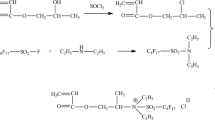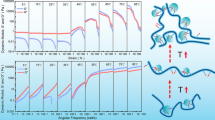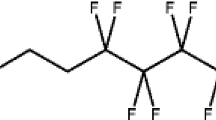Abstract
A novel class of hydrophobic associated copolymers (PASC) with nonionic surfmer was synthesized. These copolymers are the copolymerization product of acrylamide (AM), 2-(acrylamido)-2- methyl propane sulfonic acid (AMPS) and different contents of nonionic surfmer (CP). Macroscopic and microscopic self-assembly associative properties in solutions of PASC, as well as the effects of salt and temperature on the associative behavior were studied via viscosimetry, scanning electron microscope (SEM), atomic force microscope (AFM), rheology and fluorescence spectroscopy (FS). The results show that the introduced nonionic surfmer along polymer chain can lead to a strong intermolecular hydrophobic association in water. The viscosity and surface activity increased with the increase of polymer concentration and nonionic surfmer concentration. Additionally, the polymer showed a good thermal stability and good salt tolerance. Contact angle studies shows that PASC solution has good potential on change of wettability from oil-wet to water-wet. All of these properties indicate that the polymer is an excellent chemical for chemical enhanced oil recovery.












Similar content being viewed by others
References
Wang W, Liu YZ, Gu YA (2003) Application of a novel polymer system in chemical enhanced oil recovery (EOR). Colloid Polym Sci 281:1046–1054
Chen QS, Wang Y, Lu ZY, Feng YJ (2013) Thermoviscosifying polymer used for enhanced oil recovery: rheological behaviors and core flooding test. Polym Bull 70:391–401
Manrique EJ, Thomas CP, Ravikiran R et al (2010) SPE Improved Oil Recovery Symposium, Tulsa, Oklahoma, SPE 130113
Bondor PL, Hite JR, Avasthi SM (2005) SPE Latin American and Caribbean Petroleum Engineering Conference, Rio de Janeiro, Brazil. SPE 94637
Levitt DB, Pope GA (2008) SPE improved oil recovery symposium. SPE 113845
Seright RS, SeheultM Talashek T (2009) Injectivity characteristics of EOR polymers. SPE Reserv Eval Eng 12(5):783–792
Liu PD, Zhang S, Yang N (2012) A novel surface active polymer oil displacement agent. Pet Explor Dev 39:580–584
Li PZ, Shen YD, Yang XW (2011) Solution properties and flocculation of hydrophobically associating cationic fluorinated polyacrylamide. Polym Bull 67:961–973
Yahaya GO, Ahdabb AA, Ali SA, Abu-Sharkh BF, Hamad EZ (2001) Solution behavior of hydrophobically associating water-soluble block copolymers of acrylamide and N-benzylacrylamide. Polymer 42:3363–3372
Li TT, Liu HR, Zeng L, Miao WF, Wu Y (2011) Study of emulsion polymerization stabilized by amphiphilic polymer nanoparticles. Colloid Polym Sci 289:1543–1551
Wang C, Li XR, Li PZ (2012) Study on preparation and solution properties of hydrophobically associating polyacrylamide by emulsifier-free ultrasonic assisted radical polymerization. J Polym Res 19:9933
Yang XW, Liu JP, Li PZ, Liu CD (2015) Self-assembly properties of hydrophobically associating perfluorinated polyacrylamide in dilute and semi-dilute solutions. J Polym Res 22:103
Yang ZL, Gao BY (2010) Synthesis and characterization of hydrophobically associating cationic polyacrylamide. Chem Eng J 161:27–33
Renil Manat, Meidal Morten (1996) POEPOP and POEPS: inert polyethylene glycol crosslinked polymeric supports for solid synthesis. Tetrahedron Lett 37:6185–6188
Lu HS, Feng YJ (2008) Study on associative polymerizable inverse microemulsion. J Macromol Sci A 45:372–380
Ma JT, Cui P, Zhao L, Huang RH (2002) Synthesis and solution behavior of hydrophobic association water-soluble polymers containing arylalkyl group. Eur Polym J 38:1627–1633
Shashkina YA, Zaroslov YD, Smirnov VA, Philippova OE, Khokhlov AR, Pryakhina TA, Churochkina NA (2003) Hydrophobic aggregation in aqueous solutions of hydrophobically modified polyacrylamide in the vicinity of overlap concentration. Polymer 44:2289–2293
Feng YJ, Billon L, Grassl B, Khoukh A, Francoise J (2002) Hydrophobically associating polyacrylamides and their partially hydrolyzed derivatives prepared by post-modification: synthesis and characterization. Polymer 43:2055–2064
Zhong CR, Huang RH, Xu JY (2008) Characterization, solution behavior, and microstructure of a hydrophobically associating nonionic copolymer. J Solution Chem 37:1227–1243
Zhong CR, Zhang H, Feng LM (2014) Solution behavior and associating structures of a salt-tolerant tetra-polymer containing an allyl-capped macromonomer. J Polym Res 21:604
Glenn K, Van Bommel A, Bhattacharya SC, Palepu RM (2005) Self aggregation of binary mixtures of sodium dodecyl sulfate and polyoxyethylene alkyl ethers in aqueous solution. Colloid Polym Sci 283:845–853
Dutta P, Dey J, Ghosh G, Nayak RR (2009) Self-association and microenvironment of random amphiphilic copolymers of sodium N-acryloyl-l-valinate and N-dodecylacrylamide in aqueous solution. Polymer 50:1516–1525
Chen J, Jiang M, Zhang YX, Zhou H (1999) (1999) Fluorescence studies on hydrophobic associations of fluorocarbon-modified poly(acrylic acid) solutions. Macromolecules 32:4861–4866
Li GH, Shen YD, Li PZ (2010) Study of solution properties of copolymer of fluorinated surface active monomer and acrylamide. Acta Polymerica Sinica 3:347–351
Chen H, Han LJ, Xu P (2003) The thickening mechanism study of hydrophobically modified polyacrylamide. Acta Phys- Chem Sin 19(11):1020–1024
Acknowledgements
We acknowledge the financial support received from the National Natural Science Foundation of China (Grant Number: 51304029), the National Science and Technology Major Project of China (Grant Number: 2011ZX05046) and the Science and Technology Innovation foundation of CNPC Nos. 2012D-5006-0104.
Author information
Authors and Affiliations
Corresponding author
Rights and permissions
About this article
Cite this article
Li, F., Luo, Y., Hu, P. et al. Study on the self-assembly properties of surface active hydrophobically associating polyacrylamide with nonionic surfmer units. Polym. Bull. 74, 2873–2886 (2017). https://doi.org/10.1007/s00289-016-1871-4
Received:
Revised:
Accepted:
Published:
Issue Date:
DOI: https://doi.org/10.1007/s00289-016-1871-4




